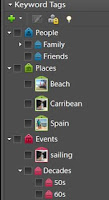 Family photos are not ordinary clutter as they are often a family's most treasured and enduring possessions. However, the steps to getting a family photo collection organized are very similar to steps suggested by professional home organizers to address ordinary clutter throughout the home.
Family photos are not ordinary clutter as they are often a family's most treasured and enduring possessions. However, the steps to getting a family photo collection organized are very similar to steps suggested by professional home organizers to address ordinary clutter throughout the home.Step 1) Inventory/Assess - Pulling out your photos, slides, albums, scrapbooks, and related items allows you to size the project and can provide some momentum to get started. This may also help you to decide which part of your family image collection to tackle first. Perhaps you decide to set aside a project area to work with just prints and albums, and then put the rest back in the closet for another day.
Step 2) Sort and Cull - The initial sort should be to decide what should be kept and what can be tossed. It can be as difficult to downsize your family photo collection as it is to get rid of clothes that no longer fit in your closet. It is likely that your collection contains some photos that add little value to your collection, and probably should have been eliminated when you had the prints developed or downloaded. Among multiple shots of the same events or subject, there are often just a few true "keepers". Sorting and culling will make the next steps more manageable, and allow you to focus your activities on the best images in your collection. This will also reduce the expense associated with storing, displaying, and sharing your images.
Step 3) Organize - The goal of organizing prints, slides, digital image files, and other image formats is similar in that the ultimate objective is to be able to easily locate an image when you go looking for it. This requires some thought about categories and a filing system. Dates, subjects, events, places, and family are some of the common organization categories. At one extreme, the organization may be as simple as prints sorted by decades. At the other extreme, a consolidated and properly captioned digital image library provides the ability to search and sort images by keywords reflecting who, what, where, when, and why.
Step 4) Contain and Store - Archival quality albums, sleeves, and boxes will help to extend the useful life of originals and protect them from harmful environmental factors such as dust, light, and accelerated chemical related deterioration. Digital images can be stored in a variety of ways and distributed more widely to extended family. When storing, one should think about the best way to backup the collection. If you have a digital library, duplicate files can be shared with other family members and placed in a safe deposit box. If you have important one-of-a-kind prints with no duplicates, consider having a few of the best prints scanned and keep the digital files at a second location and share them with extended family.
Step 5) Keep It Up - Once you are organized, add new images to the organization system you have developed. It is a good habit to cull low interest/value images as you see them, and to simply apply your organization scheme to the best ones.
For more thoughts on organizing family photo collections and to find Tips for Sorting and Culling, visit the Organizing Section at LocalArchiver.com. For a discussion of scanning considerations, visit the Scanning Section, and for storage and containment supplies, visit the Preservation Resources Section.






2 comments:
Thanks for this! I just came across your blog while searching for advice on how to organize my family photo collection, which spans the 20th century. This is all really useful information!
Patti - Glad you found it useful.
Post a Comment